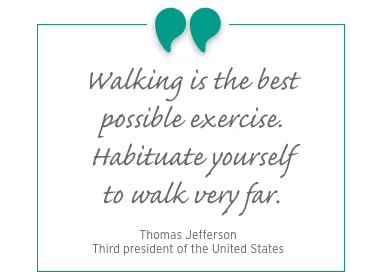How exercise can boost independence and health as we age
If you’ve always been physically active, you’re hopefully experiencing the health benefits of that consistent movement through the years.
But if you could use a little nudge toward regular exercise, here’s something to consider: It can help promote your ability to do many things, including independently care for yourself for as long as possible.
And that’s something we all have in common: the desire for independence, especially as we age.
Regular exercise later in life can help us …
Maintain independence
Older adults who exercise regularly are less likely to depend on others. They’re better able to maintain their quality of living, take care of themselves, and feel a greater level of satisfaction.
ADLs — “activities of daily living” — are the everyday tasks we do to take care of ourselves. They include dressing; meal preparation and eating; and being mobile (walking, getting into or out of bed or a chair, bathing or showering, and using the restroom).
Successful handling of one’s ADLs are typically considered the benchmark of whether a person can live independently.
And exercise can play a big part in hanging onto these abilities. According to Harvard Medical School:
-
If you want to stay healthy and mobile well into old age, start walking today — even if you’ve already edged into “old age.”
-
Older people who are physically more active and who exercise regularly are more likely to walk independently and do other activities of daily living on their own compared to sedentary elders.
-
Is it possible for inactive folks to change this scenario? Yes! A structured exercise program can make a difference even among older individuals who do not currently exercise.
Improve balance
Falls can happen from a variety of causes, including osteoporosis, medications, footwear, vision problems and home safety issues.
But one of the things that can help prevent falls is exercise. Harvard Medical School recommends making exercise a part of your daily routine:
-
Tight, inflexible, or weak muscles, together with poor posture and endurance, negatively impact balance and can lead to falls. Regular, doctor-approved exercise programs can help improve these conditions.
-
A recent analysis concluded that regular exercise may reduce the rate of falls by 23%, and the number of people who fall by 15%.
Prevent and manage disease
Health experts agree that regular exercise is one of the main things you can do to stave off chronic diseases such as diabetes — or manage the symptoms of these illnesses.
Examples:
-
Aerobic exercise can help prevent heart disease.
- And if you have indications of the disease, such as high cholesterol or high blood pressure, moderate physical activity can help stop those problems from becoming more serious ones (such as heart attack or stroke).
-
Strength training can build muscle and promote healthy joints, which can preserve mobility and function in healthy people as they age.
- And this type of exercise can also help decrease arthritis pain and can improve glucose levels in people with type 2 diabetes.
Improve brain function
Regular exercise is like a brain boost, helping enhance your memory and thinking skills. According to Harvard Medical School:
-
Exercise reduces insulin resistance and inflammation, and encourages the production of growth factors — chemicals that affect the growth of new blood vessels in the brain, and even the abundance, survival, and overall health of new brain cells.
-
Studies have shown that the parts of the brain that control thinking and memory are larger in volume in people who exercise than in people who don’t.
-
While almost all the research so far has looked at walking, it’s likely that other forms of aerobic exercise that get your heart pumping would provide similar benefits.
The bottom line? Moderate-intensity exercise can help improve your thinking and memory in just six months.
Great exercises for older adults
Before starting an exercise program — especially if you’ve been sedentary for a while — check with your doctor to see which exercises are best for your current health and fitness level.
OK — ready to start making exercise a regular part of your life? Here are some go-to favorites.
Walking
- The benefits of going for a brisk 30-minute walk every day include boosted blood flow, stronger heart and bones, better sleep and mental health, and even a lower risk of dementia.
- No special equipment needed.
- Slip on some comfortable shoes and hit the mall. Better yet, when the weather’s nice, walking outside in the fresh air, surrounded by mother nature, is extra enjoyable.
Gardening
- The habit of regularly gardening gets you out into fresh air, into nature, and moves your body enough that it can help ease some of the symptoms of osteoporosis, and lower your risk of some diseases like heart disease and depression.
Biking
- Bike riding can build strength, work the muscles that maintain balance, and improve cardiovascular health. Make sure you wear a bike helmet.
- If you have back or knee issues, try a recumbent bike, which uses three wheels, sits low to the ground, and has a seat you can lean against.
Tai Chi
- This “meditation in motion” can cut stress and improve upper- and lower-body strength — which can make you more flexible and improve your balance.
- Like walking, Tai Chi can also be enjoyed outside.
Playing with children
- Whether it’s a game of catch in the front yard or building a snowman with your kids or grandkids, this physical activity and time with kids keeps your body active and stimulates your mind.
Water aerobics
- This workout in the water uses floats for resistance and takes pressure off your joints while you build muscle tone.
- It can also improve bone health after menopause.
Swimming
- Swimming laps in an indoor or outdoor pool is a great low-impact way to work on your cardio endurance.
- If you don’t swim, try walking across the pool in shallow water.
Yoga
- With a soft mat, you can enjoy yoga indoors — or outside in the sun and fresh air.
- Gentle stretches boost your blood flow and can ease arthritis symptoms, help your heart, improve sleep and lower stress.
- If getting on the floor is difficult, or too uncomfortable once you’re there, look into chair yoga. It puts less stress on muscles and joints than more conventional forms of yoga.
Golf
- If you golfed when you were younger, you probably recall what a workout it is. You can walk up to four miles during an 18-hole game — and if you carry your clubs, your heart gets even more of a workout.
- If you’ve never golfed but would like to learn, check with a local public golf course to see if it offers lessons before you buy clubs.
Tennis
- Playing tennis can help build your cardio endurance by getting your breathing rate up in short bursts. It improves the health of your lungs, heart and blood flow.
- Check with your doctor before resuming or taking up this high-impact sport, especially if you have osteoporosis.
Pickleball
- This popular paddle sport combines elements of tennis, badminton, and ping-pong using a paddle and plastic ball with holes.
- Check with your doctor before you buy your pickleball paddle.
Even if exercise has never been your “thing,” think of it as one of the things you can do to increase your odds of living independently for as long as possible.




